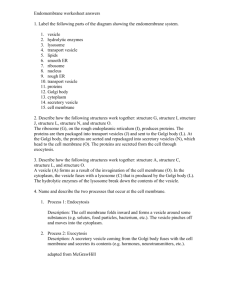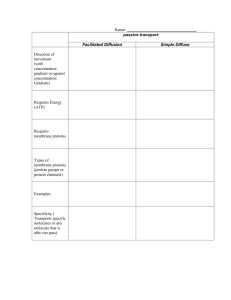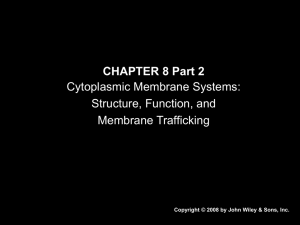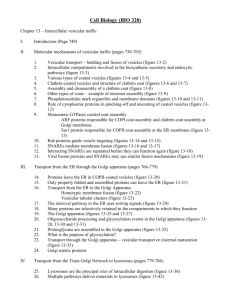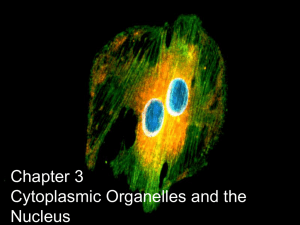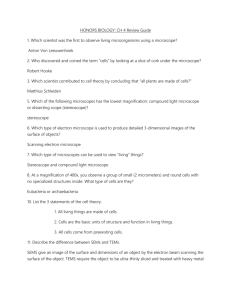CHAPTER 14 Vesicular Traffic, Secretion, and Endocytosis
advertisement
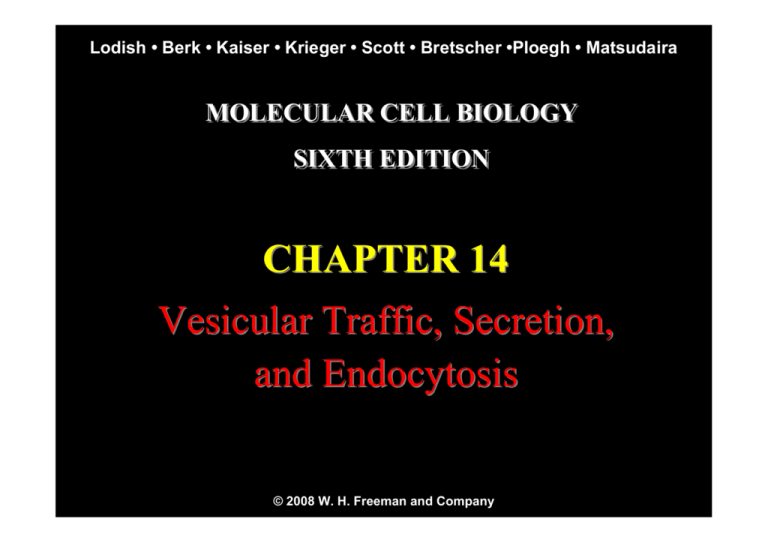
Lodish • Berk • Kaiser • Krieger • Scott • Bretscher •Ploegh • Matsudaira MOLECULAR CELL BIOLOGY SIXTH EDITION CHAPTER 14 Vesicular Traffic, Secretion, and Endocytosis ©Copyright 2008 W. H.©Freeman andand Company 2008 W. H. Freeman Company Outline: 1. Techniques for studying the secretory pathway 2. Molecular mechanisms of vesicular traffic 3. Vesicular trafficking in the early stages of the secretory pathways 4. Protein sorting and processing in late stages of the secretory pathways 5. Receptor mediated endocytosis SEM of the formation of clathrin-coated vesicles on the cytosolic face of the plasma membrane 6. Directing membrane proteins and cytosolic materials to the lysosome Secretory pathway: protein to various organelles by transport vesicles Anterograde: forward moving Retrograde: backward moving Trans position: farthest from the ER Cis position: nearest the ER Cisternal progression: cis-Golgi cisterna → cargo of protein → move form cis → medial → trans ; anterograde transport vesicle; normal TGN (trans Golgi network): proteins not transport to ER or Golgi, are destined for compartment to others (by different types of vesicles) 1. from trans → fuses membrane → trnasport → exocytosis 2. from trans → stored inside → formation of secretory vesicles; release by signal for exocytosis 3. from trans → late endosome → lysosome (intracellular degradation of organelle) the mechanism not well know endosome had endocytic pathway, from the plasma membrane bringing membrane proteins and their bound ligands into the cell Overview of major protein-sorting pathways in eukaryote (protein targeting) No signal peptide Overview of secretory & endocytic pathways: Transport vesicles transport vesicle cargo proteins same orientation anterograde transport vesicles retrograde transport vesicles cisternal progression trans-Golgi network (TGN) secretory vesicle (regulated..) constitutive secretion-exocytosis transport vesicle-late endosome endocytosis Techniques for studying the secretory pathway: Pulse-chase labeling & EM autoradiography Animal + radio AA → different time → kill → chemical fix → autoradiography Tissue sections of pancreas acinar cells -> a brief incubation (3 min) with H3-Leucine -> transfer to unlabeled medium & incubate for a period of time (0, 7, 37, 117 min) -> cover tissue sections with photographic emulsion > EM Pulse-chase exp 脈搏 Low density lipoprotein receptor 補捉 To investigate the fate of a specific newly synthesized protein Cell + isotope for 0.5h ↓ wash Different time point ↓ Immunoprecipitation ↓ Specific protein ↓ SDS-PAGE ↓ degrade PTM Glyco.. <0.5h, protein convert to mature Techniques for studying the secretory pathway: Use of temperature-sensitive mutant proteins (e.g. vesicular stomatitis virus 水疱口炎病毒 VSV G protein) At restrictive temp. of 40oC, newly made G protein is misfolded & retained within ER. At permissive temp. of 32oC, accumulated G protein is correctly folded & transported through secretory pathway. Different time course → change Temp → misfolded → stop transport Palade’s early exp had found that in mammalian, vesicle mediated transport of a protein molecule from ER to membrane about 30-60 min. Techniques for studying the secretory pathway: by living cells 1. Transport of a protein through the secretory pathway can be assayed in living cells: 1) Microscopy of GFP-labeled VSV G protein 2) Detection of compartment-specific oligosaccharide modifications 2. Yeast mutants define major stages and many components in vesicular transport 3. Cell-free transport assays allow dissection of individual steps in vesicular transport Microscopy of GFP-labeled VSV G protein Plasma membrane Use temperature-sensitive mutant, VSVG-GFP. 40oC the protein in ER 32oC move → Golgi → plasma membrane→ Form ER to Golgi about 60min Protein transport through the secretory pathway can be visualized by fluorescence microscopy of cells producing a GFP-tagged membrane protein: VSV G protein Techniques for studying the secretory pathway: 1. Transport of a protein through the secretory pathway can be assayed in living cells: 1) Microscopy of GFP-labeled VSV G protein 2) Detection of compartment-specific oligosaccharide modifications 2. Yeast mutants define major stages and many components in vesicular transport 3. Cell-free transport assays allow dissection of individual steps in vesicular transport Transport of a membrane glycoprotein from the ER to golgi can be assayed based on sensitivity to cleavage by endoglycosidaseD 電泳分離時 分子量大 分子量小 分子量大 分子量小 Cleavage by endoglycosidase D Cell expression VSV G protein → at Temp 40 → link radioactive aa and protein keep in ER → Tem 32 C → VSV G extracted → digested by endoglycosidase (about cis Golgi protein) → SDS electrophoresis From ER to golgi about 60 min Endoglycosidase can not cleavage ER’s protein. 32 C: protein move from ER → Golgi (modification) → membrane 40 C: in ER not move. Did not cleavage by endoglycosidase Protein folding ok → move → golgi → can cleavage ER to golgi In ER Addition & processing of N-linked oligosaccharides in R-ER of vertebrate cells 酶的反應是有其專一性,其反應物必需是特定的,缺一不可 Add Remove 2 mannose Remove 3 mannose In cis, specific glycosidase Cleavage by endoglycosidase D. • glycosidases (cis-) • endoglycosidase D Processing of N-linked oligosaccharide chains on glycoproteins within cis-, medial-, and trans-Golgi cisternae in vertebrate cells Techniques for studying the secretory pathway: 1. Transport of a protein through the secretory pathway can be assayed in living cells: 1) Microscopy of GFP-labeled VSV G protein 2) Detection of compartment-specific oligosaccharide modifications 2. Yeast mutants define major stages and many components in vesicular transport 3. Cell-free transport assays allow dissection of individual steps in vesicular transport Yeast sec (secretion) mutants protein The temperature sensitive mutant → grouped into 5 classes Combination of different mutant → for research of protein transport pathway, ie BD → protein in ER not Golgi → so ER is before, and Golgi is after. 利用到達的時間去計算 These studies confirmed that: cytosol → RER → ER-to Golgi transport vesiceles → Golgi cisternce → secretory → exocytosed Phenotypes of yeast sec mutants identified stages in the secretory pathway Techniques for studying the secretory pathway: 1. Transport of a protein through the secretory pathway can be assayed in living cells: 1) Microscopy of GFP-labeled VSV G protein 2) Detection of compartment-specific oligosaccharide modifications 2. Yeast mutants define major stages and many components in vesicular transport 3. Cell-free transport assays allow dissection of individual steps in vesicular transport Cell-free transport assay To plasma membrane Can not add Protein transport from Golgi cisternae to another can be assayed in a cell-free system Protein need modification in Golgi Proof: golgi can retrograde vesicular transport for modification Normal expression it demonstrated protein transport from one golgi cisterna to another Tradional Model - Golgi is a static organelle. Secretory proteins move forward in small vesicles. Golgi resident proteins stay where they are. Two Models For Cis to Trans-Golgi Progression “Radical” Model - Golgi is a dynamic structure. It only exists as a steady-state representation of transport intermediates. Secreted molecules move ahead with a cisterna. Golgi resident proteins move backward to stay in the same relative position. 問題: 到底細胞內利用vesicle的方式的機轉是什麼? Molecular mechanisms of vesicular traffic Vesicle transport: from organelle (Donor) target organelle (a) Coated vesicle: From membrane interaction with integral (b) Uncoated vesicle: Target membrane vSNARE: Crucial to fusion of the vesicle with correct target membrane tSNARE: specific joining of vSNARE Overview of vesicle budding and fusion with target membrane Assembly of a protein coat drives vesicle formation & selection of cargo molecules. A conserved set of GTPase switch proteins controls assembly of different vesicle coats Three types of coated vesicles have been characterized. All need GTP binding antrograde retrograde To endosome GTPase superfamily ARF (ADP Ribosylation Factor) Different coated proteins Clathrin and adapter protein (AP): vesicles transport proteins from the plasma membrane and trans-Golgi network to late endosomes – With AP1: Golgi to endosome – With AP2: Endocytosis (PM to endosome) – With AP3: Golgi to lysosome and other vesicles COPI: Golgi to ER (retrograde transport) COPII: ER to Golgi (antrograde trnasport) AP: complex consists of four different subunits Vesicle buds can be visualized during in vitro budding reactions. Coated vesicles Artifical membranes and purified coat protein (COP II) → polymerization of coat protein onto the cytosolic face of the parent membrane A conserved set of GTPase switch proteins controls assembly of different vesicle coats. All three coated vesicles contain a small GTP-binding protein COP I and clathrin vesicle: ARF (ADP-ribosylation factors) COP II vesicle: Sar I protein ARF and Sar I protein can switch GTP (GDP-protein → GTP-protein active; GTPase) There two sets of small GTP-binding proteins for vesicle secretion. One is ARF and Sar I; another is Rab protein ARF (ADP Ribosylation Factor) protein exchanges bound GDP for GTP and then binds to its receptor on Golgi membrane A conserved set of GTPase switch proteins controls assembly of different vesicle coats. COPII coated formation GTP → Sar1 conformational change →Sar1-GTP binding to membrane → polymerization of cytosolic complexes of COPII subunit on the membrane → formation of vesicle buds Monomeric GTPase control coat assembly Specific receptor Cargo protein Sar1 attached to Sec23/24 coat protein complex → cargo protein are recruited to the formation vesicle bud by binding of specific short sequence in their cytosolic regions to sites on the Sec23/24 → assembly to second type of coat complex composed of Sec13/31 → completed → Sec23 promotes Sar1-GTP hydrolysis → release Sar1-GDP → disassembly of the coat → transport vesicle Vesicle formation Coat assembly controlled by monomeric G-protein (SAR1 or ARF) with fatty acid tail GDP-bound SAR1 or ARF are free in cytosol Membrane-bound G-protein recruits coat protein subunits Assembly of coat pulls membrane into bud Leads to exposure of fatty acid tail membrane binding Donor membrane contains guanine nucleotide-releasing factor -causes Sar1-GDP SAR1-GTP Coated vesicles accumulate during in vitro budding reactions in the presence of a nonhydrolyzable analog of GTP Golgi membrane + COPI coat proteins and GTP → bud off Non-hydrolyzable GTP prevent disassembly of the coat after vesicle release Without exchange GTP GDP by charperone (hsp70) Major coat protein: clathrin & adaptin There are at least four types of adaptins, each specific for a different set of cargo receptor. Targeting sequence on cargo proteins make specific molecular contacts with coat protein Mistransport mechanism; retrograde Different Rab GTPases & Rab effectors control docking of different vesicles on target membranes: vesicle docking controlled by Rab protein. v-SNARE Vesicle docking controlled by Rab proteins Monomeric GTPases attach to surface of budding vesicle Rab-GTP on vesicle interacts with Rab effector on target membrane After vesicle fusion GTP hydrolysed, triggering release of Rab-GDP Different Rab proteins found associated with different membrane-bound organelles t-SNARE Paired sets of SNARE proteins mediates fusion of vesicles with target membranes. Analysis of yeast sec mutants defective in each of the >20 SNARE genes. In vitro liposome fusion assay. SNARE-mediated fusion → exocytosis → secretory protein In this case, v-SNARE as VAMP (vesicle associated membrane protein) t-SNAREs are syntaxin SNAP-25 attached to membrane by hydorphobic anchor. Formation of four-helix bundle: VAMP (1), Syntaxin (1) and SNAP-25 (2) But, in COPII with cis, each SNARE has provide one helix SNARE complex had specificity Dissociation of SNARE complexes after membrane fusion is driven by ATP hydrolysis. SNARE complex formation by non-covalent interaction. Dissociate → free SNARE → can fuse next time Two protein play important role of dissociation or fusion with a target membrane: NSF (NEM-sensitive factor, blocked by N-ethylmaleimide) & α-SNAP (soluble NSF attachment protein). hexamer Monomeric Rab-GTPases A guanine nucleotide exchange factor (GEF) recognizes a specific rab proteins and promotes exchange of GDP for GTP. GTP bound Rabs have a different conformation that is the “active” state. Activated rabs release GDI, attach to the membrane via covalently attached lipid groups at their C-termini and are incorporated into transport vesicles. Rab-GTP recruits effectors that can promote vesicle formation, vesicle transport on microtubules, and vesicle fusion with target membranes. After fusion Rab-GTP hydrolyzes GTP to GDP and is released from the membrane. GTPase activating proteins proteins accelerate hydrolysis, reducing the avalability of active rabs. Rab proteins (monomeric GTPase) help ensure the specificity of vesicle docking Soluble (i.e. cytoplasmic) Factors NSF or n-ethylmaleimide (NEM) Sensitive Factor SNAP- Soluble NSF Attachment Proteins NSF + SNAP bind to target membranes (synaptic vesicle & plasma membrane) Receptors for NSF and SNAP are synaptobrevin (vesicle), SNAP25 (plasma membrane) and syntaxin (plasma membrane) Membrane targets are called SNAREs (v- and t-) Soluble NSF Attachment protein REceptors SNAP-25- Synaptosome Associated Protein of 25 kDa • Over-expression of truncated SNAP-25 blocks release • Syntaxin, 15 kDa protein • Sensitive to botulinum toxin A cleavage - release prevented Synaptobrevin Identified and cloned ~ 1988-1990 Originally called VAMP (Vesicle-Associated Membrane Protein) and sometimes abbreviated as Syb Cleaved by tetanus toxin (failure of exocytosis = death) 破傷風毒素 Spans vesicle membrane ~ 13 kDa Inject antibodies to Synaptobrevin and release is blocked Dissociation of SNARE complexes after membrane fusion is driven by ATP hydrolysis. ATP is not actually required for release once vesicles are docked, but is thought to break down the SNARE complexes to promote recycling. 拉上拉鍊 Rizo and Sudhof 2002 Nature Rev. Neurosci. Rizo and Sudhof 2002 Nature Rev. Neurosci. Membrane fusion reactions need to overcome repulsive forces that take over when membranes approach within 3nm- hydration for ectoplasmic and cytoplasmic leaflets as well as charge repulsion in cytoplasmic leaflets. Attractive hydrophobic forces can be enhanced by membrane bending. Rab proteins (monomeric GTPase) help ensure the specificity of vesicle docking Specificity of vesicle fusion Need mechanism for selective vesicle trafficking -controlled by SNAREs and Rab proteins SNARE hypothesis proposes specific interactions between v- SNAREs and tSNAREs govern vesicle docking and fusion Each organelle has specific SNAREs leading to specific vesicle fusion Vesicle docking controlled by Rab proteins Monomeric GTPases attach to surface of budding vesicle Rab-GTP on vesicle interacts with Rabeffector on target membrane After vesicle fusion GTP hydrolysed, triggering release of Rab-GDP Different Rab proteins found associated with different membrane-bound organelles Summary Proteins moved between organelles of secretory pathway fully folded, enclosed in vesicles -proteins only have to cross ER membrane Large amount of vesicular traffic between ER, Golgi, lysosomes and plasma membrane Vesicle budding is function of protein coats Cargo selected by sorting/cargo receptors Specificity of fusion controlled by Rabproteins, v-SNAREs and tSNAREs Early stages of the secretory pathway Vesicle-mediated protein trafficking between ER & cis-Golgi Anterograde-COPII vesicle Retrograde-COPI vesicle Cargo protein vSNAREs (yellow) Rab important Membrane specific receptor bind to cargo → transport Vesicle-mediated protein trafficking between the ER and cis-Golgi Targeting sequence on cargo proteins make specific molecular contacts with coat protein COPII vesicles mediate transport from the ER to the Golgi Formation of COPII vesicles: triggered by Sec12 → induced catalyzes the GDP for GTP of Sar1 → binding Sar1 to ER membrane → followed by binding of Sec13/24 → formation of complex →second complex comprising Sec13 and 31 → interact with fibrous proteins Sec 16 → coat polymerization Sec24: interact with integral ER → transport to Golgi cytosol ER lumen Di-acidic sorting signal (Asp-X-Glu, or DXE). 3-D structure of ternary complex comprising the COPII coat proteins (Sec23, Sec24) & Sar1-GTP. CFTR: inherited disease cystic fibrosis 囊胞性纖維症 Mutation of CFTR receptor (chloride channel) phenylalamine 508→ conformational change of di-acidic sorting signal → did not interaction with Sec24→ did not formed COPII → did not transport COPI vesicles mediate retrograde transport within the Golgi and from the Golgi to the ER (ie mis-transport) Most soluble ER-resident protein carry a Lys-Asp-Glu-Leu (KDEL) sequence at C-terminus. KDEL signal & KDEL receptor: retrieval of ER-resident luminal proteins from Golgi. Both COPI and II vesicle had KDEL receptor. Retrieval system prevented ER luminal protein for folding. KDEL binding affinity is sensitive pH. It binding protein in Golgi, but release in ER. KDEL-receptors bind to KDEL-bearing proteins in the low pH environment of the Golgi and release that Cargo in the neutral pH of the ER. pH probably alters KDEL receptor conformation - regulating cargo binding and inclusion in COPI vesicles. PH high COP I vesicles mediate retrograde transport for retrieval of ER resident proteins (recycle protein) necessary for soluble secretory proteins to move anterograde without loss of ER resident proteins (e.g., PDI, BiP) ER resident proteins possess ER retrieval signals – KKXX at C-terminal end for ER membrane proteins interacts w/ COP1α/β (e.g., PDI) – KDEL at C-terminal end for ER soluble proteins interacts w/ KDEL receptor (e.g., BiP) KDEL receptor serves to retrieve KDEL tagged proteins from cis-Golgi and return them to ER – KDEL receptors localized primarily to membranes of cis-Golgi itself and to small vesicles that shuttle between ER and cis-Golgi KDEL and KKXX signals are both necessary and sufficient for ER retention Lys-Lys-X-X in KDEL receptor or membrane receptor( Retrieval of ER-resident membrane proteins from Golgi) At the very end of C-terminus, which faces the cytosol. Binds to COPI α & β subunits and retrograde to ER.

